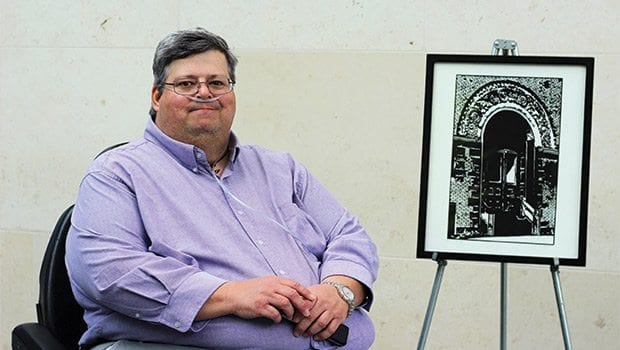
Artist Allen Chamberland has been talking for hours, but the enthusiasm in his eyes is as strong as ever. He’s one of 67 artists working with ArtLifting, an organization that helps homeless and disabled creators sell their work online. He’s also one of four artists spending Memorial Day at the Museum of Fine Arts, Boston, showcasing some of his work in a popup exhibition.
“Being able to exhibit here is beyond my wildest dreams,” says Chamberland.
Next to him are three of his pieces, paper silhouettes that he photographs and then painstakingly traces with an X-Acto knife. It can take him up to 100 hours to finish one work.

Author: Photo: Celina ColbyLori Anne Fay (right) uses cell phone cases to illustrate the inequality in Boston’s housing market.
Despite being confined to a motorized wheelchair, Chamberland’s artistic career is flourishing. He’s just been commissioned by the Harvard Business School to create six portraits of the campus’s most renowned buildings. Architecture is a favorite subject, and many of Chamberland’s works show Boston landmarks such as the Christian Science Center, Fenway Park, and the Prudential Center. Such detailed work is laborious, but it’s a labor of love. “I wouldn’t want to be doing anything else,” he says.
For artist Lori Anne Fay, her artwork is as much a creative outlet as a social megaphone. Her featured work at the MFA is a multi media composition about the instability of the housing market. Using recycled and found materials, Fay illustrates how the upper class is secure in their ability to afford the rising cost of living. This is represented by discarded phone cases that are glued to the top of the piece. The middle of the artwork shows the phone cases more loosely secured, battered, and dented. This is the middle class that struggles to hold on to the disappearing supply of affordable housing. The bottom of the piece is a disintegrated mash of plastic, a visual representation of a broken system where working class workers are often left homeless.
This choice of subject is no accident.
“My housing is gone as of tomorrow,” says Fay, who lives in Roslindale Village, next-up on the gentrification list. In addition to having no place to live, Fay has undergone a slew of medical problems including multiple severe car accidents and a degenerative eye disease that required a cornea replacement.
Despite her circumstances, Fay is unendingly positive. Her art allows her to express her creativity and heal the wounds of a harsh life. Her primary medium is photography and she’s drawn to shapes and textures in the natural world. She stands before a crowd of visitors at the MFA, strong, smiling, and grateful. Fingering the edge of her multimedia piece, she says, “I can see much better through the lens of my camera than any of the eight pairs of glasses I wear.




![Banner [Virtual] Art Gallery](https://baystatebanner.com/wp-content/uploads/2024/04/NJ-H_1-713x848.jpg)

